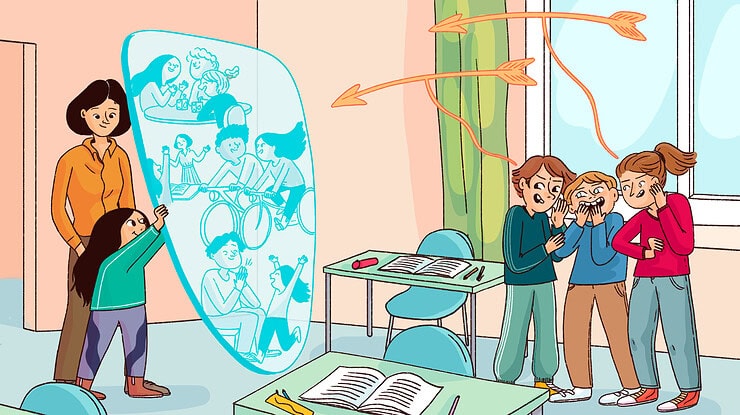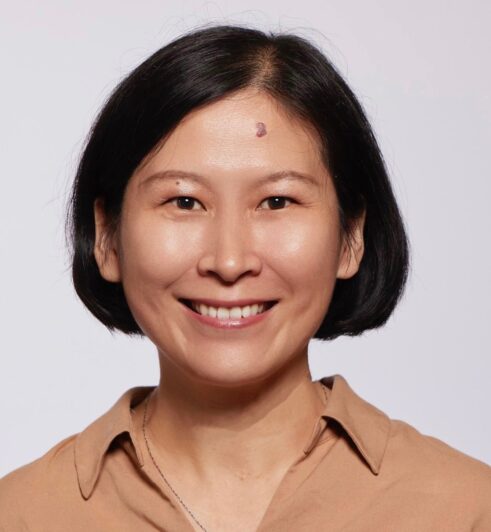The school psychologist building resilience in students and teachers
Chunyan Yang works with school communities to help them thrive

Chunyan Yang studies how young people and educators engage with their social environments, especially schools, to build resilience in the face of adversity. Annie Brookman-Byrne finds out more.
Annie Brookman-Byrne: What are you trying to understand about school systems?
Chunyan Yang: Schools are not just academic institutions. They are ecosystems where protective relationships and inclusive environments can be either cultivated or neglected. Rather than focusing on individual traits, I investigate school-wide practices such as social and emotional learning (SEL), inclusive disciplinary approaches, peer support structures, and school climate. These practices can help individuals and communities thrive despite challenges like bullying, teacher-targeted violence, mental health stressors, and marginalization in STEM learning environments.
I center the lived experiences of students and educators in promoting more just, emotionally safe, and developmentally enriching school systems.
“I center the lived experiences of students and educators.”
ABB: What drew you to explore how communities can thrive in education systems?
CY: My journey into this field has been shaped by both personal and professional experiences that have revealed to me the power, as well as the fragility, of educational systems in supporting resilience.
As an international student, a member of a racial-ethnic minority group, and then an immigrant parent, I have navigated language barriers, cultural disconnects, and institutional structures that, in many cases, weren’t built with people like me in mind. Each move – from rural Yunnan in Southwest China to cities in China, the UK, and the US – has brought new challenges and moments of growth. I slowly came to understand that educational access, belonging, and emotional safety are experienced very differently depending on one’s background. The strengths that helped me persist, including curiosity, empathy, and openness to difference, were not always recognized or nurtured by schools, but they were central to my resilience.
These insights deepened as I completed my studies and became an educator. I first trained as a science teacher in China, where I learned how instruction and engagement can open or close doors for students. Later, working as a school psychologist in US K-12 schools, I saw how students and educators from underrepresented backgrounds struggled with systemic inequities, from disciplinary exclusion to cultural misunderstanding to mental health stigma. I worked with families navigating trauma, students caught in cycles of exclusion, and teachers trying to meet their students’ emotional needs without the tools or support to do so.
“Resilience is not something individuals simply have. It is shaped by relationships, environments, and access to opportunity.”
Those experiences reinforced an insight I had gained through my lived experience: resilience is not something individuals simply have. It is shaped by relationships, environments, and access to opportunity. In my own life, I have seen how transformative public education can be for students from marginalized communities. It not only helps individuals thrive; it strengthens entire communities. As a researcher and trainer of future school psychologists, I have made it my mission to help students from underrepresented backgrounds overcome structural barriers and build the skills, confidence, and support networks they need to succeed.
ABB: What have you been working on recently?
CY: I started exploring how digital tools like dashboards, daily check-ins, and reflection apps can support school-wide SEL. These tools hold promise for tracking progress, but often feel disconnected from students’ lived experiences. I realized that they monitored growth but didn’t always spark it. I stopped asking, “How do we measure SEL?” and started asking, “How can students build SEL themselves?” – not simply as a checklist, but in a meaningful and self-directed way. I want to design experiences that are emotionally resonant, culturally grounded, and joyful.
ABB: Has working in this field changed you?
CY: Absolutely. This work has changed not only how I conduct research, but also how I parent, collaborate, and lead. It has taught me to listen more deeply, lead with humility, and design with, not for, communities. I’ve learned that resilience is not simply a trait to be taught; it is co-constructed with others and shaped by the systems we live within.
As a parent, I’ve become more attuned to how emotional safety, cultural affirmation, and curiosity can be nurtured at home. As a researcher, I’m committed to co-designing with educators, students, and families, honoring their insights and building systems that reflect their lived experiences. I no longer study interventions in isolation. I now focus on how entire ecosystems, including schools, districts, and communities, can be reimagined to foster inclusion, innovation, and wellbeing from the ground up.
ABB: What are you pursuing next?
CY: I’m excited about Co-Learn Code and Mind, a district-wide initiative I’ve begun developing in partnership with local schools and community organizations in Maryland and with researchers in computer science and learning sciences. Our vision is to reimagine STEM and SEL by integrating them into K-12 settings through inclusive, purpose-driven robotics education.
Robotics education is rapidly expanding, and now reaches over 35% of US high schools and nearly 30% of primary classrooms. Robotics is increasingly a gateway to AI education, but most programs emphasize technical skills over empathy, collaboration, and ethical reflection. This narrow focus inadvertently sidelines neurodiverse and historically underrepresented learners and reinforces longstanding inequities in STEM.
We believe school-based robotics programs can become sustainable, scalable, and joyful platforms for fostering inclusion, collaboration, social connection, identity development, and school engagement. We are establishing robotics clubs to serve as hubs for peer mentorship, community engagement, and career exploration in human-robotics interaction, social robotics design, and AI ethics. These clubs are designed to foster belonging and purpose, empowering students not just to build robots but also to envision themselves as ethical innovators and collaborators.
“Our vision is to reimagine STEM and SEL by integrating them into K-12 settings through inclusive, purpose-driven robotics education.”
The clubs will support meaningful teaching and learning not only in the fields of computer science and engineering, but also across the arts, humanities, and social sciences. In particular, we hope to transform how students, especially girls, neurodiverse learners, English language learners, and racially and ethnically marginalized youth, experience and participate in robotics innovation.
This initiative reflects the broader vision behind all my work: to create learning environments in which students and educators feel safe to take risks, connect across differences, and grow together. In an ever-evolving world, that kind of learning is not just valuable, it is essential.
Footnotes
Chunyan Yang is an Associate Professor of School Psychology at the University of Maryland, College Park. She researches how school communities interact with their environments to build resilience in the face of bullying, teacher-targeted violence, mental health challenges, and marginalization in STEM. Grounded in a socio-ecological framework, Chunyan studies how factors such as school climate, social and emotional learning (SEL) practices, and cultural norms shape development and school functioning across stakeholder perspectives. Using cross-cultural methods, she explores universal and culturally specific patterns of resilience. Currently, Chunyan examines how digital tools and robotics-based education can make school-wide SEL more scalable, sustainable, integrated and joyful. Chunyan is a 2024-2026 Jacobs Foundation Research Fellow.
Chunyan on LinkedIn, X and Chunyan’s lab website
This interview has been edited for clarity.

